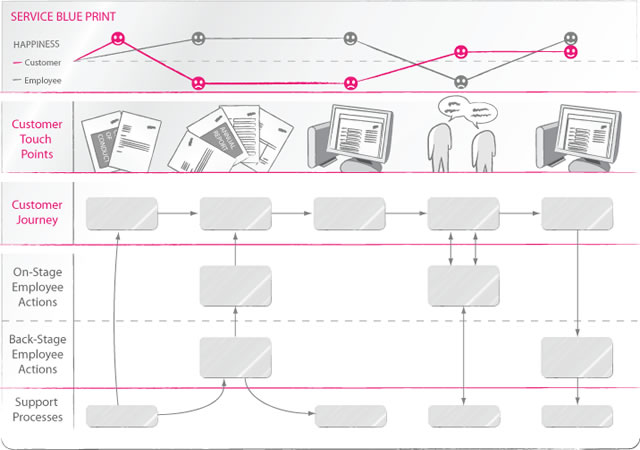
Customer Journey Mapping
I started looking at customer journey mapping late last year. Whilst a great deal has been written on the topic my favourite so far has been by the UK’s HM Government, now sadly archived and somewhat difficult to find*. Consensus seems to be that customer experience mapping starts by mapping out the sequence of touch points between a service provider and a customer, and goes on to form a level of insight into what happens at each touch point and how the customer feels about this interaction. Solid insight can help to identify the highs and lows of a customer’s experience of our service, and therefore the opportunities for service improvement. Follow this up with some good design and the service provider should be well on their way to re-inventing a more delightful experience.
Solving customer ‘jobs to be done’
In lean terms, all services are underpinned by a central value proposition of helping a customer to ‘get jobs done’. The more essential the customer jobs to be done, the more essential the service. I wrote briefly about understanding the value proposition some time last year. Applied to customer journey mapping, we should be able to use this level of insight to design services which are not only delightful, but essential as well.
Service Blueprinting
At this point I thought I was on to a pretty compelling service design concept. But something was still missing. It turns out that whilst design agencies are very good at providing advice on how to re-invent the customer journey, they are not so good at actually implementing the customer journey. Worse, the re-invented customer journey may not actually be implementable at all if the service providers internal operations cannot cope with the change. Enter service blueprinting.
The basic idea is to start with a customer journey, and map it to the underlying service delivery infrastructure (systems and processes mostly). When considered during the design phase of the ‘to be’ customer experience, we now have a ‘reality filter’ to apply to our prototype services.
Customer Experience Innovation
Combine all three, and we have (i) delightful customer experiences, (ii) focused on essential customer jobs, (iii) which an organisation believe they can actually implement within an acceptable timeframe.
Declaration of interest
I am currently developing this as a service offering on behalf of my employer, a Brisbane based management consulting group. I am posting here for feedback, as a sounding board, and because I am the author of this and other innovation services. Please contact me through my linkedin profile if you want to discuss further.
A note on HM Government
* Luckily, I managed to download the complete series of PDF’s previously made available by HM Government, which I have reposted here. They are excellent resources and well worth a read.
journey_mapping1
journey_mapping2
journey_mapping3
journey_mapping4
journey_mapping5





